Les 24 Chevaliers Part XVII: Makoto Endo (3D Director)
3D computer-generated images play an important role in this animated reconstruction of XVIII Century Europe that is Le Chevalier D'Eon. And 3D director Makoto Endo, who had mesmerized anime fans with the futuristic mechs in the Stand Alone Complex series, poured all his art and experience in an almost antithetical challenge: to represent the Chateau de Versailles using his computer. He explains us how, in this seventeenth part of Les 24 Chevaliers.
Part XVII
Makoto Endo's In principio erat Verbum: "Fusion!"
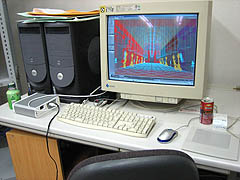 | Makoto Endo 3D Director. Born in 1974, Makoto Endo is one of the most prominent CG creators at Production I.G. He is the man behind the amazing 3D CGI in the Ghost in the Shell: S.A.C. series, Blood+, Le Chevalier D'Eon and Guardian of the Sacred Spirit. |
How did you end up joining the Le Chevalier D'Eon team?
I went to Producer Nakatake to ask if he had any 3D job that I could work on. That was when he presented me with this project. Not only that, he asked me to do the 3D rendering of the Palace of Versailles! When I saw the books and the DVD's he handed me to look at, I was astounded. The outrageous scale and the meticulous details of the artifacts and furnishings including the sculptures and the interior decorations were unbelievable. I knew I couldn't recreate the entire structure. So I started this project asking myself, "how can I approach this?"
Can you explain to us your job of 3D CG work in detail?
For Le Chevalier D'Eon, I created 3D data for backgrounds. Using the art designs and references that were available, I first created 3D model data. This is called the modeling process. When I had the shapes, I added texture. That means, in short, that I applied texture data, i.e. pictures prepared by the background artists, to the 3D models. To complete the process, I set the lighting (for morning, day or night scenes) and camera angles according to the context of the sequence where these backgrounds were used. I also did a process called camera mapping to add motion to the background. Usually, 3D CG process deals with the entire animation production, so I start with modeling, which could be labeled as the setting phase, and then I go as far as adding color and background art.
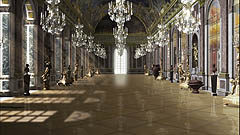
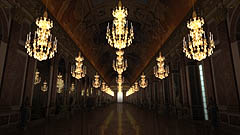
Creating the background with 3D CG was one of my prime objectives. I thought this was where the 3D section could contribute to the team; for instance, we could assist the artists who draw the background. Usually, they would have to draw separate pictures for each situation you can think of, for instance for certain times of the day or change of weather, because darkness and color change accordingly. But if you ask them to draw a background as a texture pattern and compile it into the 3D data, then we can handle any kind of setting they ask for. By utilizing the advantages of 3D CG, I think we can sort of make a fusion of 2D and 3D. So I made sure to have a thorough meeting with the artists.
Can you explain the "camera mapping" technique further?
For us in the industry this is not really a special technique. This involves adding movements to a finished 2D picture using 3D camera work. There are two methods. One is to use the camera map to match the background picture and the other method is to draw the background to match the 3D layout. The key point is how well you utilize the technique.
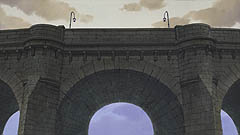
Was it particularly hard to work with Versailles, which is an existing location?
As you just mentioned, Versailles is an existing location, but the palace and its surroundings as we can see them today are a great deal different from the ones in the XVIII Century, as the building itself has underwent several modifications, both inside and outside. I should think that it was a different entity then. The reference book to check this was available at the library of Kyoto University and I used it as well as other resources. Actually the book was not in Japanese, so I had to use a dictionary to read it. This is just an example of the difficulties I faced. With all the effort I put into compiling the 3D modeling data, the data actually exceeded the capacity of the computer, and the entire system shut down when I tried to upload the data. (lol) So against my initial intentions, I had to adjust the data volume, for example, by reducing the amount of modeling or applying the reduction process in indiscernible areas. All was done by trial and error.
Was there any new stuff that you tried in the project?
In the 3D work I did for Le Chevalier D'Eon, the most critical issue was how to manage the enormous modeling data. The amount equaled the data used for a feature film. I had to find a way to make it viable for a TV series. I believe that a successful anime must have appealing animation as well as appealing backgrounds. I don't want to compromise on that. It comes down to keeping the highest quality in the background art for a TV series and at the same time be conscious of the limits of what you can put in. It is challenging.
Did you discover or gain something new from this project?
Actually, a 3D CG background was also used in the King's office and the Queen's chamber, but I used a different technique from the Hall of Mirrors. It wasn't a simple 3D data rendering. I used a variety of effect processing techniques. I hope 2D effects are also noticeable in the background. I carefully worked it out so that people would wonder whether the background was a 2D or 3D work. These rooms are always used as a background with characters in it, so I had to be careful too that the character animation and the background would go together.
Which sequence would you pick as the best sequence in Le Chevalier D'Eon so far?
Well, I would certainly say the Hall of Mirrors. It took a lot of work and time. Hope you won't miss it.
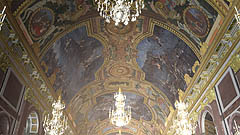
Do you have a message for the audience?
Please look hard at the background. You will be surprised to find a 3D CG background in the most unlikely places. I have left a slight trace for you to determine whether the background is a 3D CG. If you can find it, then it might be fun to guess how that background was created. I'd be happy to see someone who finds this interesting becoming a 3D CG film creator in the future.
© Tow Ubukata · Production I.G/Project Chevalier 2006

![WORK LIST[DETAILS]](/contents/works/design/images/left_title.gif)



 terms of use
terms of use